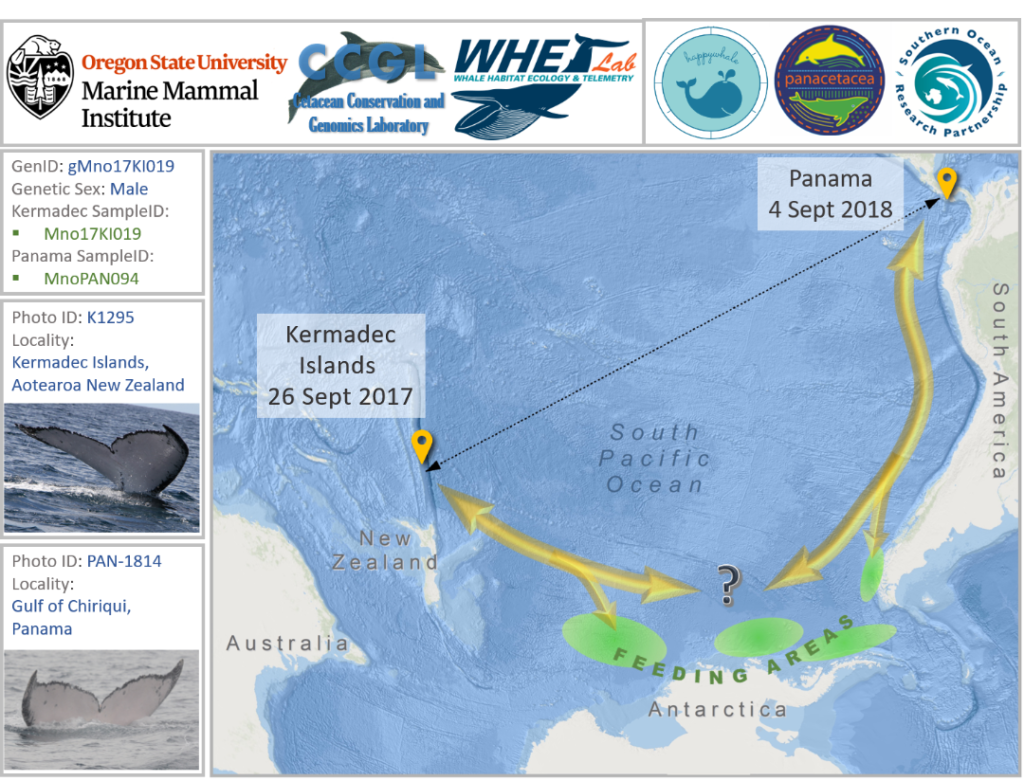by Kristin Rasmussen
Panacetacea has suspended field research on our humpback whale project for the past two field seasons (2020 and 2021), largely due to the global pandemic. This doesn’t mean that our work stops! Data analysis has continued, and recently we’ve had a very noteworthy discovery.
Between 2017 and 2019 we collected almost 200 skin/blubber tissue samples from humpback whales in the Gulf of Chiriqui, Panama. Earlier this year we sent these samples to the Cetacean Conservation and Genomics Laboratory at Oregon State University’s Marine Mammal Institute. Using DNA genotyping, they were able to identify 163 individuals from our samples. When they compared these individuals to their collection of approximately 5,000 individuals genetically identified throughout the Southern Hemisphere, they found a very interesting match. One of our Panama whales had also been seen in the Kermadec Islands – Rangitāhua, New Zealand! Researchers at the University of Auckland have studied whales in the Kermadecs as part of the Southern Ocean Research Partnership Humpback Whale Connectivity project and have discovered that this area is a migratory corridor for whales breeding in Oceania and feeding off Antarctica.
This whale was sighted off Panama in 2018 in one of the largest groups we’ve ever seen. At times there were 16 whales in this “competitive group,” an aggregation of males competing for the chance to mate with a female. These groups are often very active at the surface and show their tails frequently, so we were able to get many photo-identifications of tail flukes that day. We share all our identification photographs with Happywhale, an online collaboration platform where researchers and citizen scientists submit photos of whales seen throughout the world. A few weeks after our genetic match had been discovered, Happywhale independently discovered a photo-identification match between Panama and the Kermadecs. In each location, the photos were taken on the same day the matching genetic samples were collected. Presumably the genetic sample and photo-ID are from the same whale. When the whale was seen in the Kermadecs, it was first seen by itself breaching, then joined a mother/calf pair, and another adult. The figure below illustrates the locations where this male was sighted off the Kermadecs in 2017 and in the Gulf of Chiriqui in 2018, along with the likely migratory route between the two locations via possible Antarctic feeding grounds.
Most whales identified off Panama during the breeding season that have also been identified in feeding areas have been seen in feeding areas off the Antarctic Peninsula and Chile. However, this is not the first time one of our Panama whales has been seen farther afield. As previously reported in our blog, last year Happywhale identified another unusual match to the Amundsen Sea, west of the Antarctic Peninsula. Interestingly, many of the whales seen in the Kermadecs migrate to the Amundsen Sea to feed during the summer!
As the populations in the Southern Hemisphere recover from whaling, it’s possible that some whales are seeking new foraging and breeding areas and are wandering away from where we have typically seen them. Photo-ID and genetic techniques allow us to better understand these movements, and the relationships between the populations in the Southern Hemisphere.

Both of these discoveries could not have been made without the wide-scale collaborative effort by many researchers: the Cetacean Conservation Genomics Lab (Scott Baker and Debbie Steel), and the Whale Habitat Ecology and Telemetry Lab (Daniel Palacios) at Oregon State University, the Marine Mammal Ecology Group at the University of Auckland (Rochelle Constantine), Panacetacea (Kristin Rasmussen), and Happywhale (Ted Cheeseman), under the sponsorship of IWC/Southern Ocean Research Partnership. We would also like to acknowledge Ngāti Kuri and Te Aupōuri, the local iwi of the Kermadec Islands.


